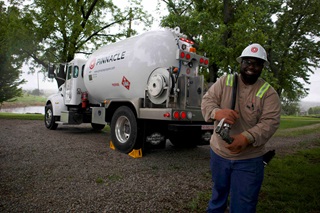How does propane refill and exchange work?
‘Is it better to refill propane, or exchange it?’
It’s a question we get from our users all the time, and frankly, it’s pretty nuanced. So let’s get started.
If you’re new to propane – maybe a cylinder came with your new grill or heater – you might be wondering what to do when you need more. Well, you have two options:
- Propane refill – reuse your empty tank by taking it to be replenished.
- Propane exchange – exchange your empty tank for a new pre-filled tank.
The best option for you really depends on your individual circumstances and priorities, and there are a range of factors to consider in this context. They include:
Let’s start at the top…
Cost – is it cheaper to refill or exchange propane?
This is an easy one. If keeping the cost down is your priority, then refilling rather than exchanging is definitely the way for you to go.
This is down to the quantity of propane. Most exchange locations short-fill tanks to 15lbs, whereas refill stations such as Pinnacle will fill your tank to its 20lb capacity. This means you go home with 25% more propane if you refill rather than exchange.
The per gallon cost of propane refill can be much lower too – up to $1.75 a gallon, in fact. This will add up to huge savings, especially if you use your propane-powered appliances on a regular basis.
What’s more, when swapping propane tanks, you’ll lose any unused propane in the tank you’re returning. A propane tank refill, by contrast, means you only pay for what you need to fill your tank.
Of course, the distance you’ll need to travel for your refill, and the eternal balance between journey cost and overall saving, should also be considered.
Convenience: Is it more convenient to refill or exchange propane?
This one is a little harder to call, as there are many more propane exchange locations out there than refill stations.
Although it’s invariably more expensive, swapping propane tanks at your local hardware store or gas station will most likely be quicker than taking your empty tank for a refill. In fact, propane cylinder exchange might be your only option if the local refilling station is closed when the tank runs out.
A good hack for this is to always have a second full tank ready, so you can immediately switch when the first one runs dry. So your grilling can continue uninterrupted and you’ll save hard-earned dollars by refilling the first tank when it’s convenient.
Environmental impact - is it better to refill propane or exchange?
This is a little more straightforward. If you’re looking for the most environmentally friendly option, then propane tank refill is the only game in town. In 2020, over 40 million individual canisters of propane were sold in the US, all of which needed to be transported to retailers – which amounts to a whole lot of trucking.
Transporting propane in bulk tankers to refill stations is massively more efficient than shipping pre-filled 20lb cylinders to exchange locations. The environmental impact is far lighter, too.
Safety
Safety is always important when using or storing propane, and the peace of mind that comes from regularly exchanging your empty tank for a full tank (which you know has been recently inspected) is definitely a check in the plus column for propane exchange.
Propane cylinders are built to last, though. As long as they’re taken care of, they’ll last for 12 years, at which point they can be inspected and recertified for an additional five. As long as you stay alert to any leaks or damage, propane cylinder refill needn’t be any less safe than propane exchange.
The verdict
Having weighed the pros and cons of propane exchange vs refill, the answer is… well, there’s no right answer. Sorry if that’s a bit vague, but there are a lot of factors to bear in mind.
When it comes to convenience and safety, the greater number of propane exchange locations, and the peace of mind that comes with knowing your cylinder has been recently inspected by a professional, can’t be ignored. Although, as mentioned earlier, a bit of forward planning and some simple maintenance mean this needn’t be a deterrent.
In terms of cost and environmental impact, there’s only one winner. If you can make it work for you, propane refill is hands down the cheapest and most environmentally friendly way to purchase propane for your appliances.
Pinnacle Propane provides refill services through retailers so why not start by finding out where your nearest refill location is and see if propane refill might be the option that works for you.



 }
}
 }
}
 }
}
 }
}